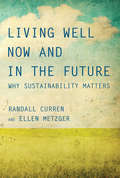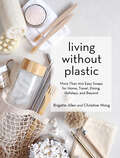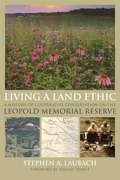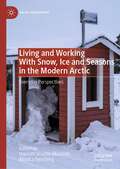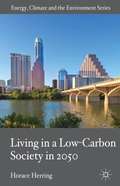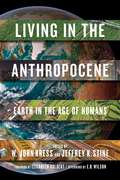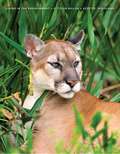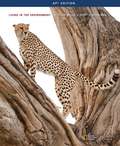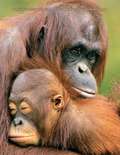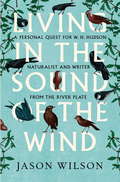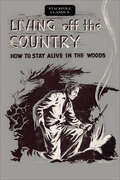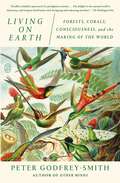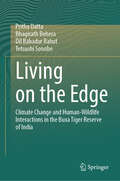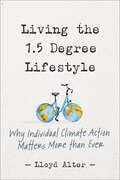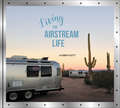- Table View
- List View
Living Through the End of Nature: The Future of American Environmentalism
by Paul WapnerEnvironmentalists have always worked to protect the wildness of nature but now must find a new direction. We have so tamed, colonized, and contaminated the natural world that safeguarding it from humans is no longer an option.
Living Through the End of Nature: The Future of American Environmentalism (The\mit Press Ser.)
by Paul WapnerHow environmentalism can reinvent itself in a postnature age: a proposal for navigating between naive naturalism and technological arrogance.Environmentalists have always worked to protect the wildness of nature but now must find a new direction. We have so tamed, colonized, and contaminated the natural world that safeguarding it from humans is no longer an option. Humanity's imprint is now everywhere and all efforts to “preserve” nature require extensive human intervention. At the same time, we are repeatedly told that there is no such thing as nature itself—only our own conceptions of it. One person's endangered species is another's dinner or source of income. In Living Through the End of Nature, Paul Wapner probes the meaning of environmentalism in a postnature age. Wapner argues that we can neither go back to a preindustrial Elysium nor forward to a technological utopia. He proposes a third way that takes seriously the breached boundary between humans and nature and charts a co-evolutionary path in which environmentalists exploit the tension between naturalism and mastery to build a more sustainable, ecologically vibrant, and socially just world.Beautifully written and thoughtfully argued, Living Through the End of Nature provides a powerful vision for environmentalism's future
Living Well Now and in the Future: Why Sustainability Matters (The\mit Press Ser.)
by Randall Curren Ellen MetzgerA philosopher and a scientist propose that sustainability can be understood as living well together without diminishing opportunity to live well in the future.Most people acknowledge the profound importance of sustainability, but few can define it. We are ethically bound to live sustainably for the sake of future generations, but what does that mean? In this book Randall Curren, a philosopher, and Ellen Metzger, a scientist, clarify normative aspects of sustainability. Combining their perspectives, they propose that sustainability can be understood as the art of living well together without diminishing opportunity to live well in the future.Curren and Metzger lay out the nature and value of sustainability, survey the problems, catalog the obstacles, and identify the kind of efforts needed to overcome them. They formulate an ethic of sustainability with lessons for government, organizations, and individuals, and illustrate key ideas with three case studies. Curren and Metzger put intergenerational justice at the heart of sustainability; discuss the need for fair (as opposed to coercive) terms of cooperation to create norms, institutions, and practices conducive to sustainability; formulate a framework for a fundamental ethic of sustainability derived from core components of common morality; and emphasize the importance of sustainability education. The three illustrative case studies focus on the management of energy, water, and food systems, examining the 2010 Gulf of Mexico oil spill, Australia's National Water Management System, and patterns of food production in the Mekong region of Southeast Asia.
Living Without Plastic: More Than 100 Easy Swaps for Home, Travel, Dining, Holidays, and Beyond
by Christine Wong Brigette Allen“An eye-opening guide on how to lessen one’s dependence on plastics. . . . This is a clarion, convincing wake-up call to the scope of the global plastic problem and what readers can do about it. —Publishers Weekly <P><P>Embrace a plastic-free lifestyle with more than 100 simple, stylish swaps for everything from pens and toothbrushes to disposable bottles and the 5 trillion plastic bags we use—and throw out—every year. Use a natural loofah, not a synthetic sponge Buy milk in glass bottles or make homemade nut milk Opt for a waste-free shampoo bar Skip the printed receipt and opt for an email instead Wrap gifts beautifully with cloth <P><P>Organized into five sections—At Home, Food & Drink, Health & Beauty, On the Go, and Special Occasions—Living Without Plastic is a cover-to-cover collection of doable, difference making solutions, including a 30-Day Plastic Detox Program.
Living Wreaths: 20 Beautiful Projects for Gift and Decor
by Natalie Bernhisel RobinsonA floral designer shares step-by-step instructions for crafting these gorgeous natural sculptures. Wreaths date back to ancient times, and still symbolize welcome and comfort today. They also range from the plain to the dazzlingly creative. From the simplest herb wreath to more extravagant succulent designs, the strong outlines and shapes of the living wreaths in this book have great visual impact. Natalie Bernhisel Robinson uses step-by-step instructions, an encouraging voice, and gorgeous photographs illustrating her techniques to teach you how to make not just a wreath but a modern garden in miniature that changes to become even more beautiful as the plants mature. Includes echeveria, hens and chicks, cactus, moss, strawberry, tomato, herb, lettuce, lavender, and more!
Living a Land Ethic
by Stephen A. LaubachIn 1935, in the midst of relentless drought, Aldo Leopold purchased an abandoned farm along the Wisconsin River near Baraboo, Wisconsin. An old chicken coop, later to become famous as the Leopold "Shack," was the property's only intact structure. The Leopold family embraced this spent farm as a new kind of laboratory-a place to experiment on restoring health to an ailing piece of land. Here, Leopold found inspiration for writing "A Sand County Almanac," his influential book of essays on conservation and ethics. "Living a Land Ethic" chronicles the formation of the 1,600-acre reserve surrounding the Shack. When the Leopold Memorial Reserve was founded in 1967, five neighboring families signed an innovative agreement to jointly care for their properties in ways that honored Aldo Leopold's legacy. In the ensuing years, the Reserve's Coleman and Leopold families formed the Sand County Foundation and the Aldo Leopold Foundation. These organizations have been the primary stewards of the Reserve, carrying on a tradition of ecological restoration and cooperative conservation. Author Stephen A. Laubach draws from the archives of both foundations, including articles of incorporation, correspondence, photos, managers' notes, and interviews to share with readers the Reserve's untold history and its important place in the American conservation movement. "
Living and Working With Snow, Ice and Seasons in the Modern Arctic: Everyday Perspectives (Arctic Encounters)
by Monica Tennberg Hannah Strauss-MazzulloThis book describes everyday practices of life in changing Arctic winter conditions. The authors explore the contemporary and situated outdoor practices in different work settings in Finnish Lapland and investigate how, for example, tourism, reindeer herding, cattle breeding and urban snow management adapt to the physically limiting or enabling features of cold temperatures, snow and ice. The book also highlights individual and societal adjustments to such harsh conditions and their seasonal changes in mobility, including winter cycling, use of snow mobiles and walking with studded shoes. The impact of a warming climate is a great concern for those utilising the enabling qualities of winter weather. The need, then, for continuous adaptation in everyday practices of work and mobility will increase in the future.
Living at a Lighthouse: Oral Histories from the Great Lakes
by Luanne Gaykowski KozmaOral histories talking about the everyday life while living at a lighthouse.
Living in Harmony: Nature Writing by Women in Canada
by Andrea Pinto Lebowitz20 Canadian women write about Origins, Explorations, Home, Encounters, Place, Gardens, For the Future, and On the Form.
Living in a Dangerous Climate
by Renée HetheringtonLiving in a Dangerous Climate provides a journey through human and Earth history, showing how a changing climate has affected human evolution and society. Is it possible for humanity to evolve quickly, or is slow, gradual, genetic evolution the only way we change? Why did all other Homo species go extinct while Homo sapiens became dominant? How did agriculture, domestication, and the use of fossil fuels affect humanity's growing dominance? Do today's dominant societies - devoted as they are to Darwinism and "survival of the fittest" - contribute to our current failure to meet the hazards of a dangerous climate? Unique and thought provoking, the book links scientific knowledge and perspectives of evolution, climate change, and economics in a way that is accessible and exciting for the general reader. The book is also valuable for courses on climate change, human evolution, and environmental science.
Living in a Low-Carbon Society in 2050
by Horace HerringCombining theory, case studies and speculative fiction, a range of contributors, from leading UK academics to pioneering renewable activists, create a compelling picture of the potential perks and pitfalls of a low carbon future.
Living in a Tree: Independent Reading Non-Fiction Pink 1a (Reading Champion #515)
by Jackie WalterThis book is part of Reading Champion, a series carefully linked to book bands to encourage independent reading skills, developed with UCL Institute of Education (IOE)Living in a Tree is a non-fiction text exploring the different animals that live in trees. The repeated sentence structure offers readers the opportunity for a very first independent reading experience with the support of the illustrations.Reading Champion offers independent reading books for children to practise and reinforce their developing reading skills.This early non-fiction text is accompanied by engaging artwork and a reading activity. Each book has been carefully graded so that it can be matched to a child's reading ability, encouraging reading for pleasure.
Living in the Anthropocene: Earth in the Age of Humans
by Edward O. Wilson Elizabeth Kolbert Thomas E. Lovejoy John W. Kress Jeffrey K. StineExplores the causes and implications of the Anthropocene, or Age of Humans, from multiple points of view including anthropological, scientific, social, artistic, and economic.Although we arrived only recently in Earth's timeline, humans are driving major changes to the planet's ecosystems. Even now, the basic requirements for human life--air, water, shelter, food, nature, and culture--are rapidly transforming the planet as billions of people compete for resources. These changes have become so noticeable on a global scale that scientists believe we are living in a new chapter in Earth's story: the Anthropocene, or Age of Humans. Living in the Anthropocene: Earth in the Age of Humans is a vital look at this era. The book contextualizes the Anthropocene by presenting paleontological, historical, and contemporary views of various human effects on Earth. It discusses environmental and biological systems that have been changed and affected; the causes of the Anthropocene, such as agricultural spread, pollution, and urbanization; how societies are responding and adapting to these changes; how these changes have been represented in art, film, television, and literature; and finally, offers a look toward the future of our environment and our own lives.
Living in the Environment (17th Edition)
by G. Tyler Miller Scott E. SpoolmanThis book provides you with basic scientific tools for understanding and thinking critically about the environment and the environmental problems we face.
Living in the Environment: Principles, Connections, and Solutions
by G. Tyler Miller Scott E. Spoolman Jr.Learn how to make a difference in our environment! Using sustainability as the central theme, this current and thought-provoking book provides you with basic scientific tools for understanding and thinking critically about the environment and the environmental problems we face. Updated with new information, art, and "Good News" examples, this engaging book offers vivid case studies and hands-on quantitative exercises. The concept-centered approach transforms complex environmental topics and issues into key
Living in the Environment: Principles, Connections, and Solutions (13th Edition)
by G. Tyler MillerMiller's LIVING IN THE ENVIRONMENT, 13th Edition is a science-based book designed for introductory courses in environmental science. Tyler Miller is the most successful author in environmental science instruction because of his attention to currency, trend-setting presentation, outstanding student and instructor supplements, and his ability to retain and refine the pedagological hallmarks on which instructors have come to depend. In this edition Miller has added an on-line Web- based resource, entitled the Resource Integration Guide, which is updated quarterly with CNN. Today video clips, animations, and articles from InfoTrac. College Edition. Instructors can seamlessly incorporate current news articles and research findings to support classroom instruction. And, for the first time ever, students will receive a complementary CD-ROM entitled Interactive Concepts in Environmental Science. This groundbreaking addition integrates nearly 100 engaging animations and interactions with chapter summaries, flashcards, and Web-based quizzes. Organized by chapter, students will find links to relevant resources, narrated animations, interactive figures and prompts to review material and test themselves. The content in the Thirteenth Edition of LIVING IN THE ENVIRONMENT is everything you have come to expect and more.
Living in the Environment: Principles, Connections, and Solutions (Wadsworth Biology Ser.)
by Jr. G. Tyler MillerNIMAC-sourced textbook
Living in the Sound of the Wind: A Personal Quest for W.H. Hudson, Naturalist and Writer from the River Plate
by Jason WilsonW. H. Hudson was brought up on the pampas, where he learnt from gauchos about frontier life. After moving to London in 1874, Hudson lived in extreme poverty. Like his friend Joseph Conrad, Hudson was an exile, adapting to England. He never returned to Argentina.Wilson unravels Hudson’s English dream, his natural history rambles, and his work to protect birds. He remains both a complex witness to his homeland before mass immigration and to his England of the mind, before the urban sprawl.Praise for Jason Wilson: Tireless, shrewd, erudite Jason Wilson, mixing hard fact and anthology, provides the perfect outfit of allusion and comparative experience - Jonathan Keates, ObserverPut his treasure trove into your pocket. - Anthony Sattin, Sunday TimesThe idea is so simple that it must be original. This inaugural book might prove to be a landmark. - Nicholas Shakespeare, Daily Telegraph
Living off the Country: How to Stay Alive in the Woods (Stackpole Classics)
by Bradford Angier&“If you&’re planning any wilderness adventure, you would do well to get acquainted with the valuable information in this book.&” —Nature magazine Living off the Country helps outdoor enthusiasts enjoy time in nature without worry, offering take-along tips for finding free appetite fillers, thirst quenchers, weapons and warmth in all kinds of situations. In a clear and understandable way, Brad Angier provides a harvest of handy, helpful hints about the necessities of life . . . where to look for the natural-growing supply of edible, unusual, taste-tickling plants, bushes, and fruit; make-shift but sure-fire ways to catch fish; easy ways to utensil-less cooking; handily constructing off-beat shelters; best ways to conserve and use available clothing; what to do about finding your way; backwoods medicine for emergencies . . . and much more help anyone enjoying the outdoors understand how to stay alive in the woods. For any kind of wilderness adventure, pack Living Off the Country with other survival gear.
Living on Earth: Forests, Corals, Consciousness, and the Making of the World
by Peter Godfrey-SmithOne of the Washington Post's 50 Best Nonfiction Books of 2024The bestselling author of Other Minds shows how we and our ancestors have reinvented our planet.If the history of the Earth were compressed down to a year, our species would arise in the last thirty minutes or so of the final hour. But life itself is not such a late arrival: It has existed on Earth for something like 3.7 billion years—most of our planet’s history and over a quarter of the age of the universe (as far as we can tell). What have these organisms—bacteria, animals, plants, and the rest—done in all this time? In Living on Earth, the philosopher Peter Godfrey-Smith proposes a new way of understanding how the actions of living beings have shaped our planet. Where his acclaimed books Other Minds and Metazoa explored the riddle of how conscious minds came to exist on Earth, Living on Earth turns to what happens when we look at the mind from another side—when we come to see organisms as active causes, not merely as results of the evolutionary process. The planet we inhabit is significantly the work of other living beings, who shaped the environments that we ourselves later transformed. To that end, Godfrey-Smith takes us on a grand tour of the history of life on earth. He visits Rwandan gorillas and Australian bowerbirds, returns to coral reefs and octopus dens, considers the impact of language and writing, and weighs the responsibilities our unique powers bring with them, as they relate to factory farming, habitat preservation, climate change, and the use of animals in experiments. Ranging from the seas to the forests, and from animate matter’s first appearance to its future extinction, Godfrey-Smith offers a novel picture of the course of life on Earth and how we might meet the challenges of our time, the Anthropocene.
Living on the Edge: Climate Change and Human-Wildlife Interactions in the Buxa Tiger Reserve of India
by Tetsushi Sonobe Pritha Datta Bhagirath Behera Dil Bahadur RahutIn a rapidly changing climate, understanding the complex interactions between humans and wildlife is crucial for fostering coexistence. This book offers an in-depth analysis of how climate change exacerbates conflicts between local communities and wildlife in the Buxa Tiger Reserve. Through historical insights, current challenges, and community narratives, it reveals the adaptive strategies employed by villagers and their unintended consequences on wildlife. Readers will gain valuable insights into the cascading effects of these conflicts and find evidence-based policy recommendations aimed at promoting sustainable and harmonious coexistence. Essential for conservationists, policymakers, and anyone interested in sustainable development, this book provides practical solutions for mitigating human-wildlife conflicts in the face of climate change.
Living the 1.5 Degree Lifestyle: Why Individual Climate Action Matters More than Ever
by Lloyd AlterStop thinking about efficiency and start thinking about sufficiency Living the 1.5 Degree Lifestyle reveals the carbon cost of everything we do, identifying where we can make big reductions, while not sweating the small stuff.The international scientific consensus is that we have less than a decade to drastically slash our collective carbon emissions to keep global heating to 1.5 degrees and avert catastrophe. This means that many of us have to cut our individual carbon footprints by over 80% to 2.5 tonnes per person per year by 2030. But where to start?Drawing on Lloyd Alter's journey to track his daily carbon emissions and live the 1.5 degree lifestyle, coverage includes:What it looks like to live a rich and truly green lifeFrom take-out food, to bikes and cars, to your internet usage – finding the big wins, ignoring the trivial, and spotting marketing ploysThe invisible embodied carbon baked into everything we own and why electric cars aren't the answerHow to start thinking about sufficiency rather than efficiencyThe roles of individuals versus governments and corporations.Grounded in meticulous research and yet accessible to all, Living the 1.5 Degree Lifestyle is a journey toward a life of quality over quantity, and sufficiency over efficiency, as we race to save our only home from catastrophic heating.
Living the Airstream Life
by Karen FlettIllustrated with rare and exclusive images from the official company archives, an authoritative and entertaining guide to the wildly popular, beautifully designed luxury recreational vehicle that has become a cultural icon, embodying the American spirit of freedom and adventure—and the ideal in mobile living.With its distinctive silver-bullet shaped profile, the Airstream has been an integral part of the American recreational landscape for more than eighty-five years. Since the 1930s, thousands of Americans have used it as a personal canvas to paint their own unique story as they’ve traveled the road of life, and today, these stunning, nostalgia-laden vehicles are more popular than ever. In Living the Airstream Life, Karen Flett tells the unique story of the designers who have transformed the brand into a mainstay of American life and the dreamers who have found their home, and their heart, in an Airstream. Living the Airstream Life is a tour along the diverse roads aficionados have taken in chasing their Airstream dreams. Stunning color photographs featuring new and vintage versions and compelling stories capture the allure of the Airstream and offer advice and insight on the practicalities of adopting this lifestyle. With spectacular photography and compelling stories, Living the Airstream Life offers inspiration for those actively pursing the dream of life on the road—whether for permanent living or as a temporary escape from the daily grind—and everyone who wants to live vicariously through those who dare.
Living the RV Life: Your Ultimate Guide to Life on the Road
by Marc Bennett Julie BennettWhether you’re downsizing or thrill-seeking—or anything in between—find out if the RV lifestyle is right for you, and learn how to transition from a life of traditional home-ownership to one on the road. Do you love traveling? Meeting new people and seeing new places? Are you craving a life that feels meaningful and new? The RV lifestyle could be the answer. Both aspirational and practical, Living the RV Life is your ultimate guide to living life on the road—for people of all ages looking to downsize, travel, or work on the go. Learn if life in a motor home is right for you, with insightful details on the experiences of full-time RV-ers, tips for how to choose an RV (how big? new or used?), whether to sell your home (and if not, what to do with it), model costs, sample routes and destinations, basic vehicle maintenance, legal and government considerations—and much more! Written in a light and an easy-to-understand style, Living the RV Life is your bible to living a mobile life.


